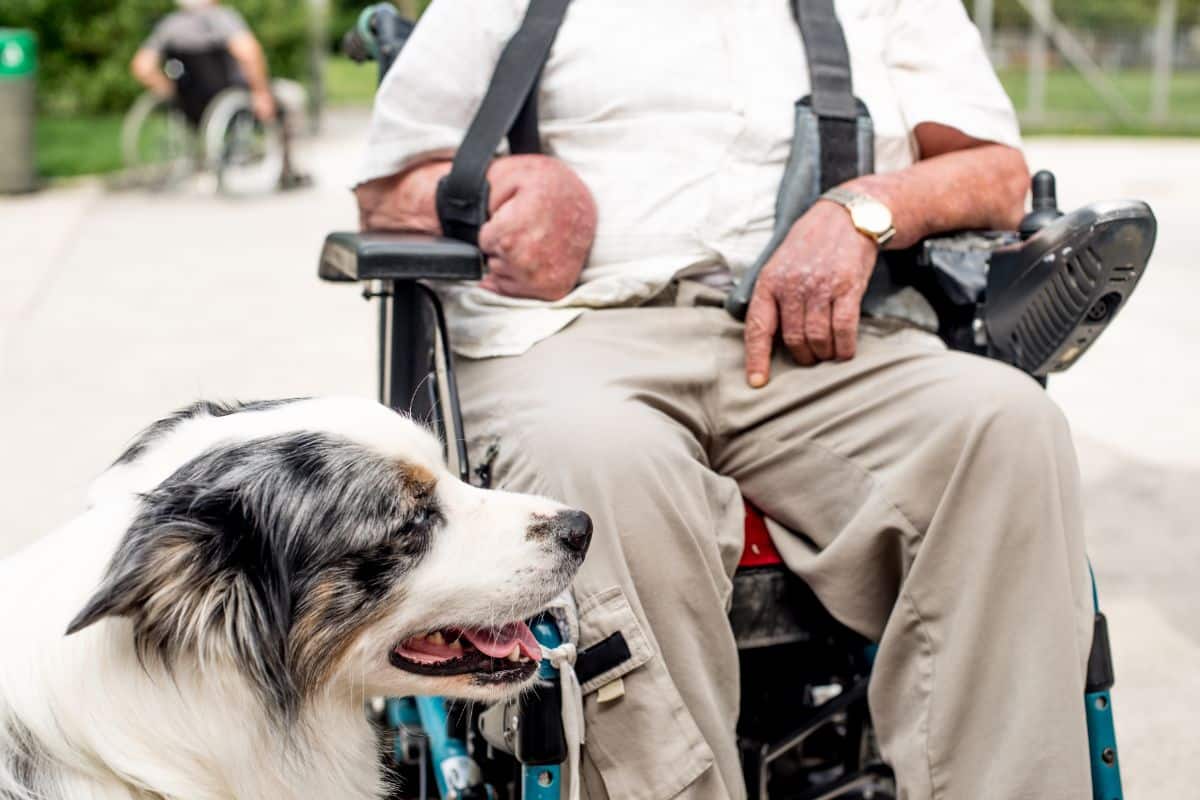There are various new therapies being tried out for helping people with mental health, one of them being emotional support dogs (or ESAs). These are dogs that help people during hard times, offering a friendly face and some comfort during stress, depression, or isolation.
The idea behind this is that dogs really help people, providing companionship to the lost and the lonely. But this is something not a lot of people know about, and it is worth clarifying so that you can know what to do when you next encounter someone who has an ESA with them.
What types of emotional support dogs are there? How can you get one, either for yourself or for a friend or relative? Well, we’ll give you all the relevant information on emotional support dogs, so you can understand better the function they serve.
Emotional Support Dogs – What They Do?
When someone is suffering from mental anguish, it is important that they feel safe and supported. But with some people, it is not always possible for them to have support from a carer full-time. Therefore, having a four-legged companion that they can be around 24/7 helps to keep their mood stable.
Symptoms can arise at any time, so for someone who does experience severe mental health problems, it is important that they remain in a relatively calm state of mind throughout the day. Socialization is also very important for people who have mental health problems.
Emotional support dogs will help people to integrate into society and improve their quality of life. It will also help them to negotiate public transport, which is important for completing their daily tasks.
If someone is suffering from PTSD late during the night and experiences feelings of extreme isolation and loneliness, then having a canine presence there is crucial. During a severe PTSD episode, having that animal there could make all the difference and actually avert hospitalization.
Emotional support dogs serve the same function as a therapy dog or a service dog, except the animal will live with the patient or client 24 hours a day.
What Types Of Support Dogs Can You Get?
There are mainly 3 types of support dogs, all of which serve different functions and help members of the community with different abilities.
Service Dogs
These types of dogs serve both a practical and therapeutic service. They do live with the person they are working with, but they help them with certain tasks. For example, if a person is partially sighted or totally blind, then a service dog will help guide them when it comes to walking down the street.
Similarly, if a person is deaf, then the service dog will act as their ears. There are also dogs that are trained to turn someone over into the correct position if they are epileptic and are suffering from a seizure.
In this sense, service dogs are not really classed as emotional support dogs, as they perform tasks that ESAs are not really trained in. An ESA will not really have any training in any specific field or task, their job is to comfort during times of anguish.
Emotional Support Animals (ESAs)
These types of animals are the ones we are going to be focusing on in this article. As we have mentioned previously, this type of dog has mainly a therapeutic purpose, meaning it does not have any specific training. You can get many support animals that take many different forms, not just dogs.
You can get emotional support from cats, birds, fish and even hedgehogs. If this animal provides some form of comfort to the person in question, then they are technically classed as an ESA. In more recent years, they have even had support animals like miniature horses.
This animal not only helps the user feel comfortable but also helps them feel secure and safe, taking solace in grooming and general care.
Therapy Dogs
This kind of support animal is usually only used within the confines of the hospital, being brought in by various veterinary practitioners. They are unlike emotional support dogs in that they do not live with a person. These animals can be brought into children’s wards to help improve their mood before or after surgery.
These serve a very important function in that they help people recover emotionally, which is an important part of the overall recovery process. So, these are the 3 main types of support animals and the differences between them.
If you are searching for an animal to live with someone who experiences chronic mental health issues, then you will need to request an ESA rather than a therapy dog.
Is An Emotional Support Dog the Same As A Psychiatric Assistance Animal?
There is a very specific subset of service dogs that are called psychiatric assistance dogs, which also act in a practical as well as a therapeutic function for their owners. These types of dogs also have training. They can prompt their owners when it is time to take their medication, which is important if their memory is impaired by their condition.
These animals can also interrupt problematic behaviour, which is very important in the case of severe OCD. If behaviour is repetitive and leads to a spike in anxiety, then the psychiatric assistance animal generally interrupts it in a passive manner that does not cause additional anxiety.
This dog will also help to provide physical support, which is useful if the owner is out and about and is suddenly overcome by a dizzy spell. This type of dog is becoming very popular in the USA, although you will have to get a referral from a doctor before you can acquire one of these animals.
You can also get additional financial assistance from a non-profit organization or a charity, although you will have to prove that your life is significantly affected by mental health conditions.
So, an emotional support dog is not the same as a psychiatric support animal in that they do not have any specific training and do not really intervene physically if any adverse symptoms arise.
In the case of emotional support dogs, you could say that the animal acts in more of a passive role, with the owners seeking assistance from them when they require it.
The Benefits Of Having An Emotional Support Dog

No quantitative scientific study suggests that emotional support dogs improve the quality of life for a person with mental health issues. However, there is a large majority of anecdotal evidence to suggest that ESAs do have a positive impact on the life of their owners. Here are a few things that emotional support dogs are said to help with:
- Managing stress – the presence of an animal is reported to have calming physical effects on the person, which is effective if they have a background level of anxiety that tends to spike.
- Alleviating worries – it has been anecdotally suggested that concentration on outside objects tends to alleviate internal fixation on internal problems. This is one of the main principles of mindfulness, which has been shown to reduce the adverse effects of depression.
- Reducing isolation – one problem for people with severe mental health issues is that they might live alone, so having a dog there might make them feel less isolated.
- Distracts from negative thoughts – as we have mentioned above, focusing on something outside of yourself will relieve anxious thought patterns.
- Sense of purpose – When you are severely depressed, it is difficult to find goals, so feeding and looking after an animal gives an owner concrete aims and objectives.
- Companionship – Not only will these dogs reduce isolation, but they will also increase the sense of companionship, which is very important for combatting loneliness in general.
- A feeling of belonging – this can also help people to socialize, which will reduce their fear of others and help to integrate them as part of the community.
These are the more general psychological aspects that emotional support dogs help with. However, there are practical, day-to-day tasks that an emotional support dog can help to maintain which regulate good mental health.
- Giving routine – when somebody is suffering from poor mental health, it can be a disruption to their routine. However, caring for, feeding, and walking an animal can provide that sense of structure, upon which a regular routine can be built once again.
- Exercise – this has been described as one of the backbones of solid mental health, so making sure that you go out once a day to walk your dog will keep you active, healthy and, hopefully in the long run, happy.
These types of dogs are used for quite extreme cases of mental illness such as PTSD. But they are also used to help people who are suffering from autism who might also experience enhanced levels of anxiety daily. Here are some of the ways that ESAs help these people:
- Autism – dogs can help people feel a connection as well as socialise with them and give them responsibility. Anecdotal evidence suggests that an ESA helps a person with autism achieve a sense of independence and responsibility.
- Schizophrenia – this can help people with extreme conditions such as schizophrenia and bipolar, helping to anchor them when their conditions get too severe.
- People with severe injuries – anyone who is recovering from an injury or is undergoing surgery will be suffering from a low mood, which is why introducing an animal into their life will help lift their spirits and aid the recovery process.
ESA Certification
Sadly, there is no official recognition of support dogs in the UK. This means that if you have a dog, it will be regarded as a pet, no matter what. This might be an issue if you are travelling or trying to bring your dog to certain indoor areas.
There are some airlines that are generally accepting of emotional support animals and will allow them on board planes. Here are the airlines that will make special exceptions when it comes to emotional support dogs:
- Ryanair
- EasyJet
- Virgin Airlines
However, certain airlines such as British Airways do not allow emotional support animals on their airplanes. You should make sure that you contact the airline before travelling to ensure that they allow emotional support animals on their airlines.
You should be wary of certain websites that state that they can provide certification of ESAs in the UK. There is currently no official documentation that gives special permission or certification to people with emotional support animals in the UK. Any website that does offer this type of certification is usually a scam website.
What Does The UK Law Say About Emotional Support Dogs?
In the UK, these dogs are not classed in the same bracket as service dogs, so they do not get the same allowances. You might not be able to enter certain cafes or restaurants with an emotional support dog, as they do not have the same license as a guide dog.
The way to negotiate around this problem is by going to the manager of the restaurant, cafe or institution that you are planning on visiting with your ESA and seeing what the policy is. Because the law does not recognise these dogs as service dogs, then business owners are under no legal obligation to allow them onto their premises.
How Do I Acquire An Emotional Support Dog?
There are certain charities in the UK that do help people who want to obtain emotional support dogs. However, some of these charities focus predominantly on autistic people owning support dogs rather than those suffering from mental health problems.
It might be important to get the backing of a charity when it comes to ESAs, as they will be able to help you clarify your rights and also obtain financial aid for your support animal.
This is the process that you have to follow in the US if you want to acquire an emotional support dog:
- Visit a licensed health professional – this is the first step that you need to take. You need to get an official evaluation by a psychologist, psychiatrist, therapist, or councillor for them to grant you a qualification for an ESA. Usually, only someone whose life is severely impaired by their mental health will qualify for an ESA.
- Risk management – this is again left up to the medical professional to adjudicate. This is to minimise the risk of harm and abuse, both animal and the client.
- Prescription – if the medical professional has decided that you will need an ESA, then this will be prescribed as part of your treatment. You will be given an ESA letter of support that you will need to take with you when you visit restaurants or take a flight.
As we have mentioned above, sadly this practice is not available in the UK. Any website that claims to offer the above accreditation is false and usually a scam website that takes a fee for such a certification.
What Breeds Of Dogs Make The Best ESAs?

There are a few species that better lend themselves to being emotional support animals. The most important thing is developing a bond of trust with your animal. If you are going to be relying on them in times of hardship, then having that close bond will be very important.
Here are some of the traits that you should be looking for in your emotional support animal:
- Loyalty – you’ll need to make sure that your ESA does not run away, especially when they are spooked in a public situation.
- Calm – your ESA will need to remain calm when they are in a stressful situation. The purpose of your ESA is to calm you down, not make you more anxious.
- Positive – your dog has a positive and energetic demeanour will automatically lift your mood, which is important if you are going through a down period.
Here are the breeds of dog that have the above traits and are more suitable for being emotional support animals:
Cavalier King Charles Spaniel
These dogs are extremely affectionate as well as petite, which makes them great for travelling with. They are great dogs to have if you have never owned an animal before and they do not require a lot of exercises, which makes them ideal if you do not have that much space.
This is a great indoor dog, which is useful if you have any anxieties about going outdoors.
Golden Retriever
These dogs are extremely popular in the ESA community, and they also make great therapy dogs. Friendly, loyal, and patient, these dogs are perfect for helping you out emotionally and physically. These dogs are also physically robust, which is great if you need support during fainting spells.
They are very affectionate and like nothing better than to snuggle up to their owner day and night. They require a moderate amount of exercise, but this might be beneficial if you want to exercise, and you are craving a little bit of routine.
Pomeranian
This dog is another very small and very cute breed, ideal for taking with you on various trips, which is exactly what you’ll need from a support animal. They are very affectionate animals, giving you the physical support that you need when you are feeling low.
Border Collie
This is another dog that will rarely display aggression, rather expressing itself in pure love. This is also a very loyal breed of dog, perfect for helping anyone in a stressful social situation.
This dog will need roughly 2 hours of exercise during the day. This makes them one of the most physically demanding dogs that you can have, but if you think you can handle them, they are a great source of exercise.
These types of dogs are often prescribed to anyone who has depression, as the activity levels will help them to stimulate their mind as well as their body, helping them to get out of the house.
Which Is The Best Dog Breed For My ESA?
If you are going to want to take your dog on public transport or flights, then you might prefer to have a smaller breed, as they will be much easier to store. Keeping them close to you will also help with anxiety.
Larger breeds, on the other hand, might be harder to transport, but they will give you a sense of security or protection that you find reassuring. These larger breeds are better for people who only want to travel short distances.
You’ll also have to consider the upkeep of your animal, budgeting for their food and having the amenities to keep them healthy and fit. Here are some of the things that you’ll have to consider when looking after your animal:
- Food – most dogs will need feeding twice a day, so make sure that you have enough food for at least 14 servings per week.
- Water – keeping your dog hydrated will be crucial, especially if they are going to be an energetic breed that you’ll be exercising on a regular basis.
- Room to move – you’ll have to make sure that your dog has enough room to move around, as this will help keep their joints in good condition.
- Grooming – it will be important to keep your dog fit and healthy, not just in terms of exercise, but also how often they are clipped and cleaned. You’ll have to give your pooch a good scrub at least once a month.
- Medical treatments – it is more than likely that your emotional support dog will suffer some illness or injury that will have to be treated by a vet.
Conclusion
If you are struggling with mental health issues or know somebody that is, then having an emotional support animal might be exactly what you need to improve your symptoms. With the right dog, you can gain more confidence, independence, and a sense of security.


